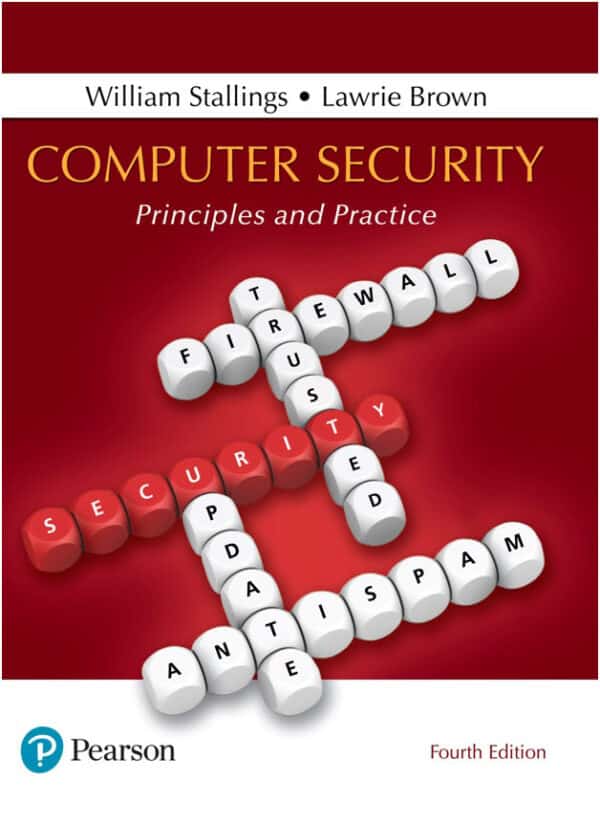Computer Security: Principles and Practice (4th Edition) – An Essential Guide for Modern Cyber Defense eBook PDF
Introduction:
In today’s interconnected world, where technology plays a vital role in our daily lives, computer security has become a paramount concern. The rapid evolution of cyber threats calls for a comprehensive understanding of computer security principles and practices. In this article, we explore the eBook “Computer Security: Principles and Practice” in its fourth edition, a valuable resource that equips readers with the knowledge and tools to safeguard their digital assets.
Overview of the eBook:
“Computer Security: Principles and Practice” serves as a comprehensive guide written by William Stallings and Lawrie Brown. Now in its fourth edition, this book covers a wide range of topics, providing readers with a deep understanding of the principles, technologies, and best practices in computer security.
Key Topics Covered:
- Introduction to Computer Security: The eBook begins by introducing the fundamental concepts and goals of computer security, emphasizing the importance of protecting information and ensuring the confidentiality, integrity, and availability of data.
- Cryptography: Cryptography plays a pivotal role in securing digital communications and transactions. This eBook explores various cryptographic techniques, algorithms, and protocols, enabling readers to understand how encryption and decryption mechanisms work.
- User Authentication: Effective user authentication is crucial to preventing unauthorized access. The book explains different authentication methods such as passwords, biometrics, and multi-factor authentication, shedding light on their strengths and vulnerabilities.
- Access Control: Access control mechanisms determine who can access resources and what actions they can perform. This eBook delves into access control models, policies, and mechanisms, offering insights into the design and implementation of robust access control systems.
- Network Security: With the proliferation of networked systems, securing networks is of utmost importance. The authors explore network threats, vulnerabilities, and countermeasures, covering topics like firewalls, intrusion detection systems, and virtual private networks (VPNs).
- Malicious Software: This section provides an in-depth understanding of various types of malicious software, including viruses, worms, Trojans, and ransomware. Readers will gain insights into malware detection techniques and strategies to mitigate risks associated with such threats.
- Web Security: As the internet serves as a breeding ground for cyber threats, securing web applications and services is critical. This eBook delves into web vulnerabilities, secure coding practices, and emerging technologies like Transport Layer Security (TLS) and Secure Sockets Layer (SSL).
- Security Management and Risk Assessment: To establish a robust security posture, organizations need effective security management and risk assessment practices. This section explores risk analysis, incident response, disaster recovery, and business continuity planning.
Conclusion:
“Computer Security: Principles and Practice (4th Edition)” offers readers a comprehensive and up-to-date guide to the ever-evolving world of computer security. By covering a wide array of topics, from foundational principles to advanced techniques, the eBook equips readers with the necessary knowledge and skills to protect their digital assets.
As cyber threats continue to grow in sophistication and frequency, it is essential for individuals, organizations, and aspiring security professionals to stay abreast of the latest security practices. “Computer Security: Principles and Practice” serves as an invaluable resource, empowering readers to navigate the complex landscape of computer security and make informed decisions to mitigate risks effectively.
Whether you are a student, IT professional, or technology enthusiast, this eBook will serve as a practical and insightful companion, enabling you to develop a strong foundation in computer security and contribute to a safer digital world.
Chapter 1: Introduction to Computer Security The ebook begins by providing a solid foundation in computer security by introducing the fundamental concepts, terminologies, and objectives of security. It explores the ever-evolving threat landscape and the potential consequences of inadequate security measures. The chapter highlights the importance of a proactive and comprehensive approach to security.
Chapter 2: Cryptographic Tools Cryptography plays a vital role in securing information and communications. This chapter delves into various cryptographic tools and techniques, including encryption, digital signatures, and hash functions. The ebook explains their applications in protecting data integrity, confidentiality, and authentication.
Chapter 3: User Authentication User authentication is a critical aspect of computer security, ensuring that only authorized individuals gain access to sensitive resources. This chapter examines different authentication mechanisms, such as passwords, biometrics, and two-factor authentication. It emphasizes the importance of implementing strong authentication protocols to mitigate the risk of unauthorized access.
Chapter 4: Access Control Access control mechanisms dictate who can access specific resources and under what circumstances. The ebook explores access control models, such as discretionary access control (DAC), mandatory access control (MAC), and role-based access control (RBAC). It discusses the design and implementation of access control policies to enforce security and prevent unauthorized actions.
Chapter 5: Security Policies and Models Developing effective security policies is crucial for organizations to establish a robust security posture. This chapter introduces security policies and models, including the Bell-LaPadula model, the Biba model, and the Clark-Wilson model. It guides readers in formulating policies that align with an organization’s security objectives and regulatory requirements.
Chapter 6: Network Security As the digital world becomes increasingly interconnected, network security is of utmost importance. This chapter covers various network security concepts, including firewalls, intrusion detection systems (IDS), virtual private networks (VPNs), and secure protocols. It provides insights into securing networks against external threats and ensuring data confidentiality and integrity.
Chapter 7: Malware and Software Security The ebook dives into the realm of malware and software security, examining different types of malicious software, such as viruses, worms, and Trojans. It discusses secure coding practices, software vulnerabilities, and the importance of regular patching. The chapter also addresses the concept of software assurance and the challenges associated with it.
Chapter 8: Web Security With the proliferation of web-based applications, web security has become paramount. This chapter explores common web security vulnerabilities, including cross-site scripting (XSS), SQL injection, and cross-site request forgery (CSRF). It provides guidance on secure web application development, secure coding practices, and web security testing methodologies.
- ISBN-10: 0134794109, 0134794184
- ISBN-13: 9780134794105, 9780134794181


